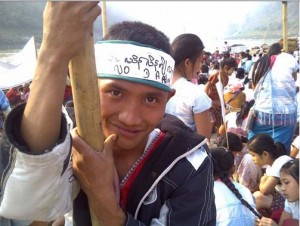Fate of Salween Dams Remains Unclear
Originally appeared in Mizzima
March 18, 2013 Some 2,000 internally displaced people and villagers from the Wei Gyi area gathered on March 14 by the Salween riverbank to protest continued plans to construct six hydroelectric dams on the river.
Some 2,000 internally displaced people and villagers from the Wei Gyi area gathered on March 14 by the Salween riverbank to protest continued plans to construct six hydroelectric dams on the river.
The ceremony, which included prayer services by a Buddhist monk and a Christian pastor, was also attended by community leaders from Dawei, who themselves are resisting massive development projects in their area.
One day earlier, the environmental NGO Salween Watch released a report outlining the current status of the Salween River in response to an announcement made by Myanmar’s deputy minister for electric power in late February that six controversial dam projects on the river had been granted approval.
“With a combined installed capacity of 15,000 MW, the projects will include the Upper Salween or Kunlong Dam, the Mai Tong or Tasang Dam, Nong Pha Dam, Mantawng Dam (on a tributary), Ywathit Dam, and Hatgyi Dam. The investment will come from five Chinese corporations, Thailand’s Electricity Generation Authority of Thailand (EGAT) International Co Ltd and three Burmese corporations,” said the Salween Watch report.
The river is one of the world’s last free-running rivers and runs from the Tibetan Himalayas through Myanmar and Thailand to the Andaman Sea. Numerous companies have expressed interest in harnessing the river’s power; however, many of the 13 proposed dam projects have come under criticism as severe human rights abuses have been reported in the militarized dam sites, including land grabs, forced labor and rape.
Several of the dams are being planned in areas where continuing conflicts are occurring between ethnic resistance groups and the Myanmar army and their construction is said to undermine any potential ceasefire negotiations.
The Salween Watch report states that this month alone more than 1,000 Myanmar troops were sent to Nong Pha Dam, fueling fears of a new large-scale military offensive in the area.
In 2009, the Myanmar army launched an offensive when local people resisted the construction of the Kunlong Dam forcing 30,000 people to flee across the Chinese border.
According to Karen human rights groups, in mid-2009 the Myanmar army and Democratic Karen Buddhist Army (DKBA) attacked the Karen National Union (KNU) based in Pa-an.
“As a result, about 3,500 villagers, mostly women and children, fled across the Thai border into the Tha Song Yang district of Tak. This was the largest influx of war refugees from Karen State into Thailand in a decade,” states the report.
A Karen environmental activist, Paul Sein Twa, commented: “The Burmese [Myanmar] government should show their sincerity by halting all large-scale development projects pending genuine peace talks and political reform. Only this will ensure protection of community rights. Right now, private investors are stifling the hopes of the Karens for a lasting peace.” Read KESAN’s press release here.
Speaking on Thursday at the ceremony on the riverbank, Naw Phyo Phyo of the Karen Women’s Organization said that Naypyitaw and foreign investors must desist from implementing any development project, including dams, during this fragile ceasefire period, as genuine peace is not yet guaranteed.
“Current development projects will only benefit a few people— mainly governments and investors—but local people like us will face huge challenges, including permanent loss of our lands, displacement, hunger and severe flooding. This will have many negative impacts on our environment and our livelihoods,” she said.
Another community leader, Pati Saw Ko, said, “We all want development, but development must not bring suffering and difficulty for local communities.”
View the original article here.
Tags: Karen State, Protest, Salween DamThis post is in: Business and Human Rights, Environmental and Economic Justice, People's Voices
Related PostsBurma Army Displays Blatant Disregard for 21st Century Panglong Peace Process
Karen State September 2016 Conflict: The Real Motivations Behind Renewed War
Burma Army’s actions in Karen State threaten to expand fighting, endangering peace process and displaced people’s return
JSMK Update: Treating More than One Problem
Hpa-an Situation Update: Hlaingbwe and Paingkyon townships, March to May 2016









 All posts
All posts